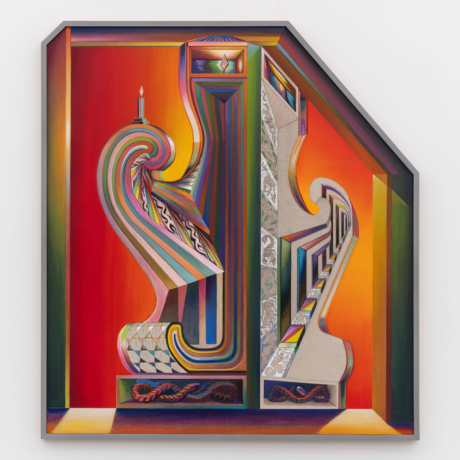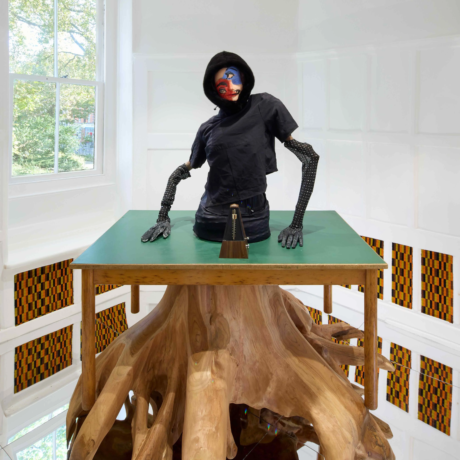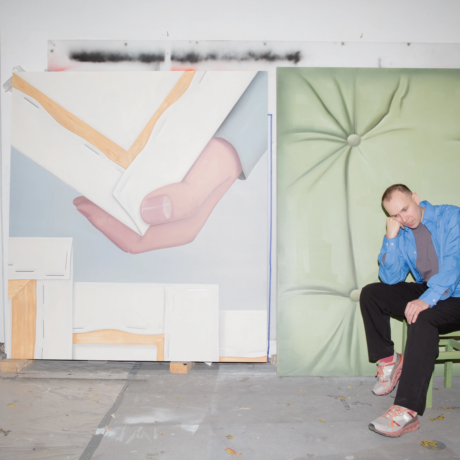The first-ever Ethiopia Pavilion to land at the Venice Biennale, Prejudice and Belonging superimposes Addis Ababa-born artist Tesfaye Urgessa’s careful observation of religious iconography on his “dramatised” understanding of the body. Informed by the chiaroscuro triumphant in Caravaggio’s art as well as by Lucian Freud’s unflinching portrayal of the human condition, Urgessa’s expansive canvases fuse distant eras and cultures in a nuanced exploration of the emotional glue that binds us all together. To celebrate the unveiling of his Venetian solo presentation, Elephant spoke with him about his early creative inspirations, the mark that relocating to Germany left on both his life and production, and how Prejudice and Belonging seeks to pave the way for more Ethiopian artists to be recognised internationally.
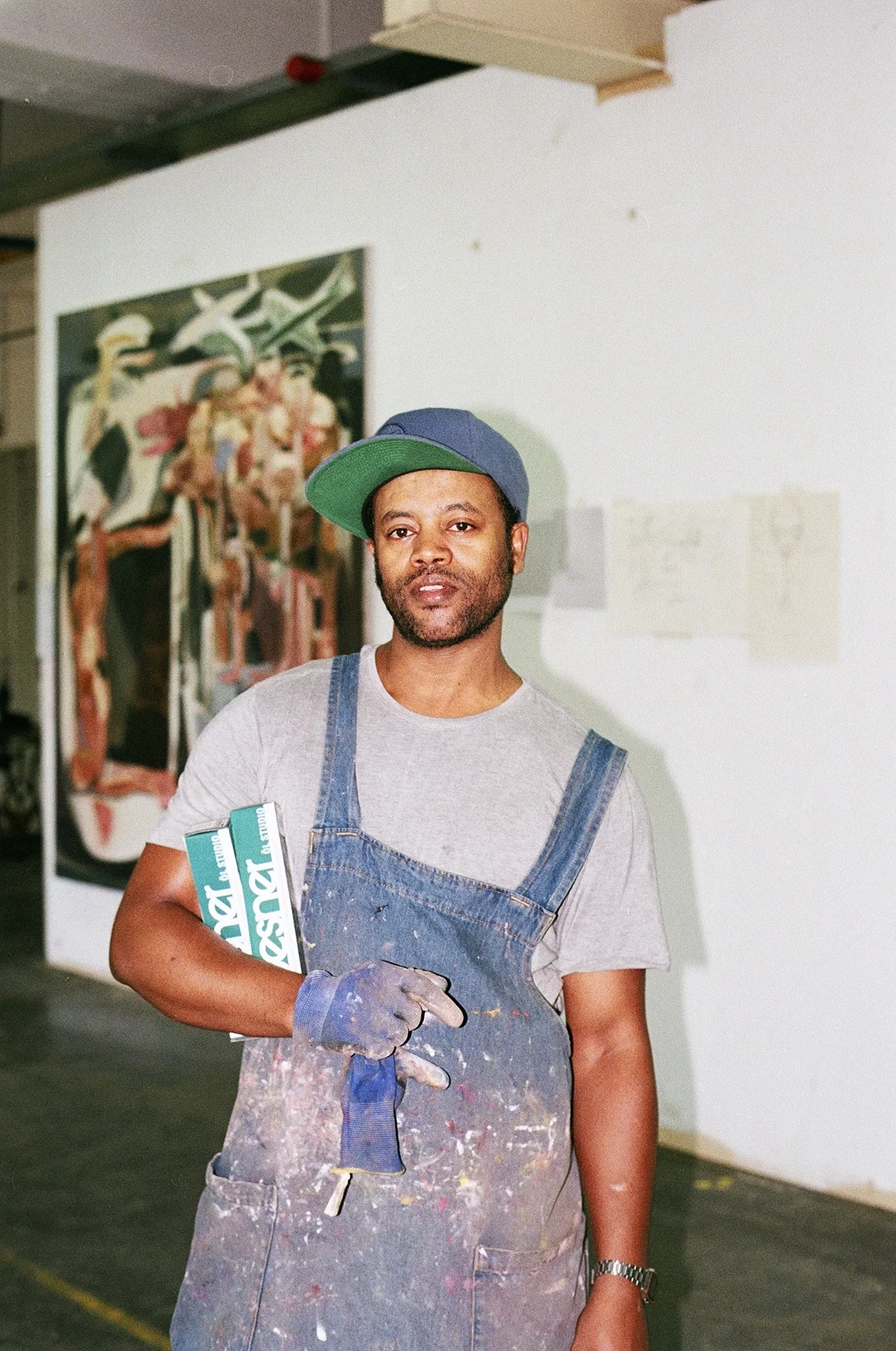
GB: Thank you for taking the time to speak with me today, Tesfaye. Let’s start from the real beginning: what concrete experiences prompted you to take up art in the first place?
TU: It runs in the family. When my father was in his mid 40s, he met a local artist who impressed him so much that he decided to learn how to draw and paint himself. He would primarily work in watercolour and gouache, copying small church paintings. I grew up watching him doing that, so when my brother and I showed interest in art, he immediately supported us. Instead of looking at art books, we would spend our days teaching ourselves how to copy the models featured in the fashion magazines my father would bring home for us. Sometimes, he even gave us a little prize for the best drawing—that was the beginning.
GB: Stemming from the encounter between Ethiopia’s centuries-old heritage and your discovery of German Neo-Expressionism and the London School of Painters, your practice is a melting pot of influences that sews the gap between Africa and Europe. What does your eclectic visual style reveal about your biography?
TU: Through my late teenage years, I didn’t know that art could be a profession nor was I aware that there were thousands of artists making art all around the world. What I did know were Ethiopia’s typical church paintings because, just like my father, I had recreated them many times. The closest thing I knew to art were the bright depictions of saints, angels and other religious figures I saw whenever I went to church, so I began to copy those to learn how to mix the colours. It wasn’t until my older brother joined an art school for a summer programme that I realised that there were countless techniques, methods and ways to approach artmaking. My formal education in art, which I first gained from the University of Addis Ababa, then taught me how to draw from a model as well as colour theory, composition and other aesthetic fundamentals. At the beginning, my aim wasn’t to become an artist, as I didn’t even know what that meant; I just wanted to be good at drawing and painting. When I moved to Germany in 2009 to pursue an MA at Stuttgart’s State Academy of Fine Arts, I finally understood this was what I wanted to do. From there, I combined the more academic way of thinking about line, anatomy and colour with the freedom to experiment I discovered once I relocated to Europe… and here I am now.
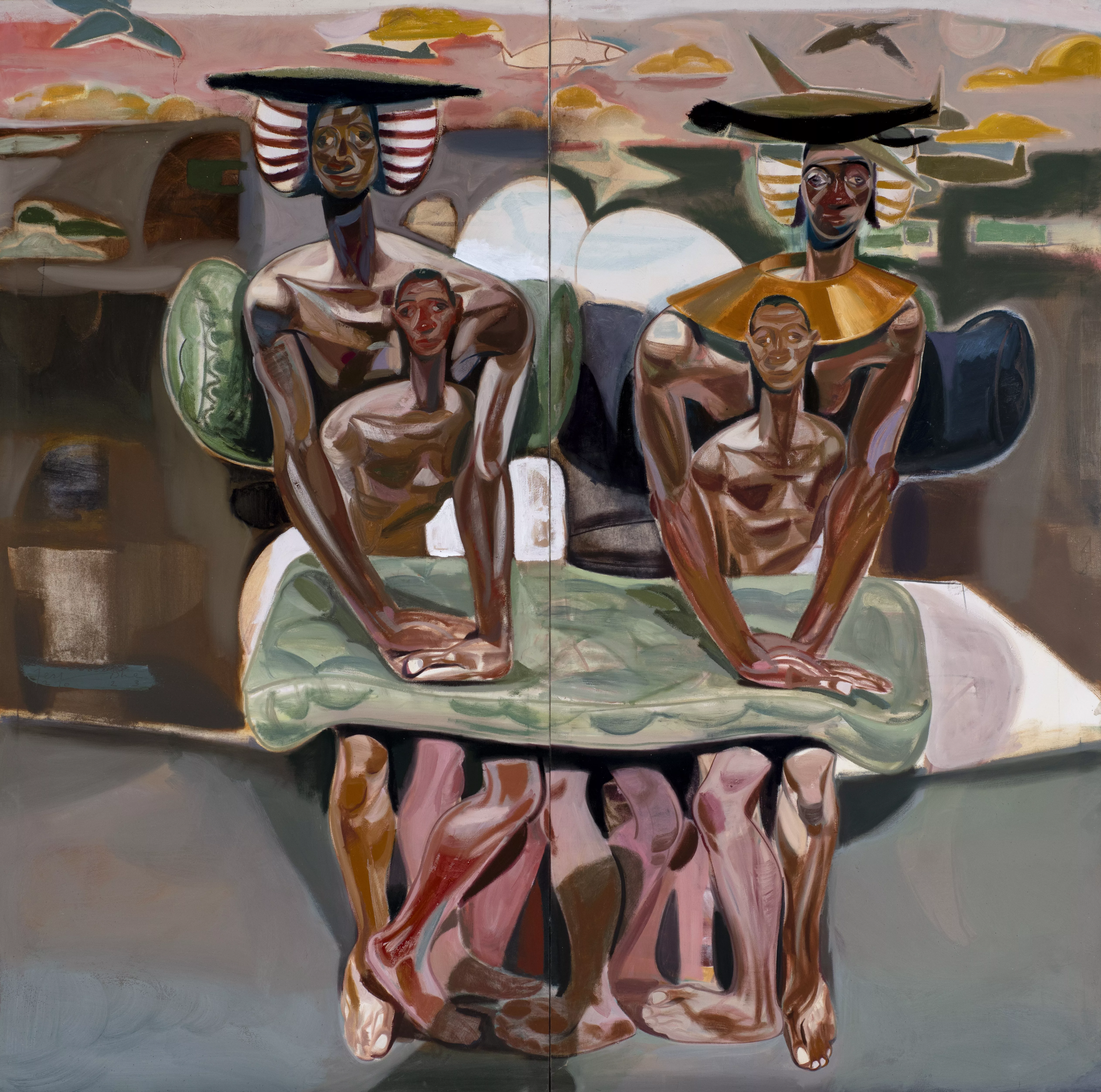
GB: When I look at your work it is almost impossible not to notice the great emphasis you place on the human form and the diverging physical, psychological and emotional states which mould it into shape. To what extent are your canvases a portal into your own personal dimension?
TU: All of my paintings and drawings strive to capture what it actually means to be human—from our tragedies to our greatest achievements and moments of joy. Most of my work emerges from feelings of powerlessness: instead of sticking with me, that sensation naturally leaks onto the canvas. This is tangible in the varying expressions of the figures I paint. Still, however happy or sad, my subjects are never meant to be seen as victims by the viewer; rather, I just want them to represent life in its most comprehensive definition, embodying both the scars and confidence that got them where they are today. When you think about it, even a neutral face can be perceived as intimidating, and that is because not knowing what lies behind that expression makes us feel uncertain. But for me, that neutrality doesn’t stand for a lack of emotion; quite the opposite, it is the synthesis of multiple and contrasting emotional turbulences, rendered together and all at once.
GB: My instant reaction to the dynamism, the existential turmoil and bold pairing of colours that define your paintings was one: Francis Bacon. What inspirations are woven into your signature aesthetic and how did you come to uncover them?
TU: Interesting guess! I always say that Lucian Freud is my main reference. When I first came across his work while studying in Ethiopia, I didn’t find it appealing: something about his strokes, so short and not very fluid, almost disturbed me. It was only during my second year of university in Germany that I began to look at his paintings from a different perspective. At some point, they became very prominent in my mind and I started to research ways to reach that same powerful, compelling quality in my work by diving into his production. While doing that, I said to myself that I would stop painting human beings with two hands just because, at least in theory, they have two, if I felt that one was enough.
I didn’t know how to achieve that until my classmates and I travelled to Italy: on that trip, I saw a Caravaggio painting hanging in a church which was a revelation. I had seen his work before, but that time it felt different. Caravaggio had this dramatic way of covering up body parts with a shadow which I found absolutely fascinating. Suddenly I realised I could hide specific body parts with colour. Weirdly enough, the first artwork I made after that, which merged my love of Freud with that of Caravaggio, ended up looking like a Bacon. Compared to my previous ones, this new painting looked quite violent – something I initially struggled to accept. Somehow the fact that people compared my more recent pieces to Bacon’s raw, filterless portraiture allowed me to come to terms with their emotional intensity.
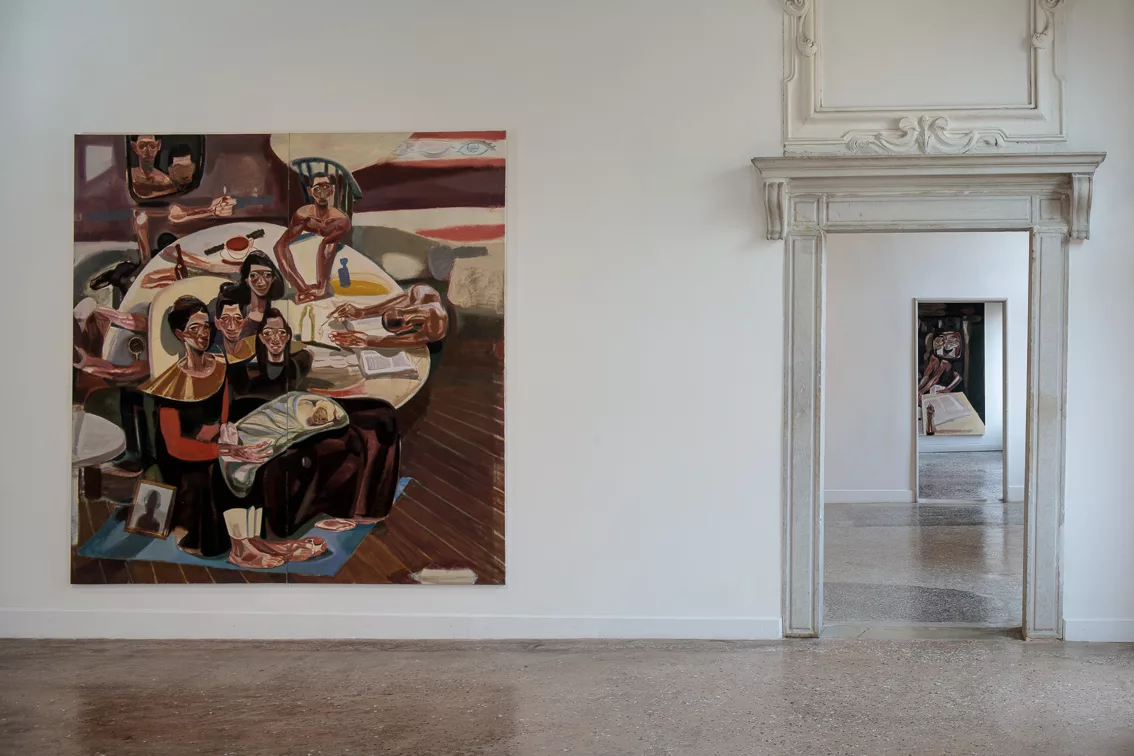
GB: Just like the title of your Venetian presentation, Prejudice and Belonging, both your life and artworks are characterised by ambivalence: first surfaced in Ethiopia, your craft has reached its current state during the years you spent in Germany, becoming a mirror into your experience of migration. What was that shift like?
TU: When I first came to Germany, I thought I would go back to Ethiopia after finishing my degree, but as is often the case, life happened in the middle: I met my wife and decided to stay here long-term. Suddenly I had to cope with things I hadn’t considered before, starting with surveillance. Going to places like Stuttgart’s central station was especially uncomfortable as police would search me or look at me suspiciously for no reason. When my partner and I got kids, I realised that was going to be part of their life too. To this day, whenever I hear a story related to that or anything similar happens to me, I turn to painting as a channel to process my feelings. Since I speak much better German now, things have gotten easier. But this isn’t something that only affects me; it also impacts every other foreigner living in a foreign land. This is what I am trying to convey in Prejudice and Belonging, which aligns with the theme of this year’s Biennale, Foreigners Everywhere.
GB: The 60th Venice Biennale is the first one to present an Ethiopia Pavilion, which shares its International Art Exhibition debut with 6 other African countries including Benin, Senegal and Tanzania. What can you tell us about the journey that led to Prejudice and Belonging, which is currently on view at Palazzo Bollani?
TU: I started working on these paintings about a year ago from a group of canvases which I gradually expanded into ten large-scale works. I also made some small portraits and a few middle-size pieces. I knew I wanted to express the vision behind them without being too illustrative about it, so I researched the foreigner experience and came up with loads of questions about it which I then asked myself while painting. The next step was translating the answers I came up with directly into the pictures. What I love about this body of work is that, although the themes it touches upon may show the human being as fragile, when looked at as a whole the paintings feel incredibly strong and empowering. I strongly believe in the importance of introducing our culture and artist community to the rest of the world, not just for our creatives, but for Ethiopia as a whole. To be invited to do so was both an honour and a huge responsibility.

GB: For decades Westerners have put all African art into a box without considering the multiplicity of its disciplines and perspectives. What are the biggest misconceptions about African creative traditions? How does your work remedy that?
TU: It all comes down to a lack of recognition. For years, the contribution of African countries to the art world has been completely neglected. We see it in art history: realism was invented in Egypt, but then the Greeks took it, modified it and passed it on to the Romans. From there, it was handed down across generations till present day. Again in the 1800s, artists got bored with their reality and decided to search for new inspiration: Monet became fascinated with Asia, Paul Klee went to Tunisia, while Picasso looked at African masks. Still, when they came back, none of them acknowledged the influence that those countries had had on their art. Nowadays, partly thanks to the internet, it is much easier for artists from all over to produce and exhibit work and get noticed for it. Ethiopia has a very dynamic art scene and, although the community is small, it is making waves. Compared to Sudan and Egypt, which focus more on watercolours, and Western African nations like Ghana and Nigeria, which experiment with sculpture and wood carving among other mediums, Ethiopia is known for reinterpreting Byzantine painting through the lens of Ethiopian tradition. With this show, I aim to open a door for our vibrant art movement to become more visible and bring new light to the country. I want to help other Ethiopian artists understand that they can play big and international – that they can exhibit anywhere they wish to.
GB: As countries like Italy and the UK set out to counter new migration waves through controversial policies legitimising the removal of incoming refugees to Albania and Rwanda, respectively, a dialogue on the migratory experience has never been more necessary. What do you hope visitors will take home from Prejudice and Belonging?
TU: I would like everyone dealing with similar circumstances to find some comfort and understanding in my paintings – that is the best thing I can hope for from my art. Politicians know that by preaching fear, they can gain power. In recent years, more and more countries have been turning to fear as a weapon to confuse the masses and mobilise them against foreigners. Ensuring people are aware of this is the only way to prevent it from happening over and over again and lay the foundations for a better futureeveryone can enjoy.
Words by Gilda Bruno
